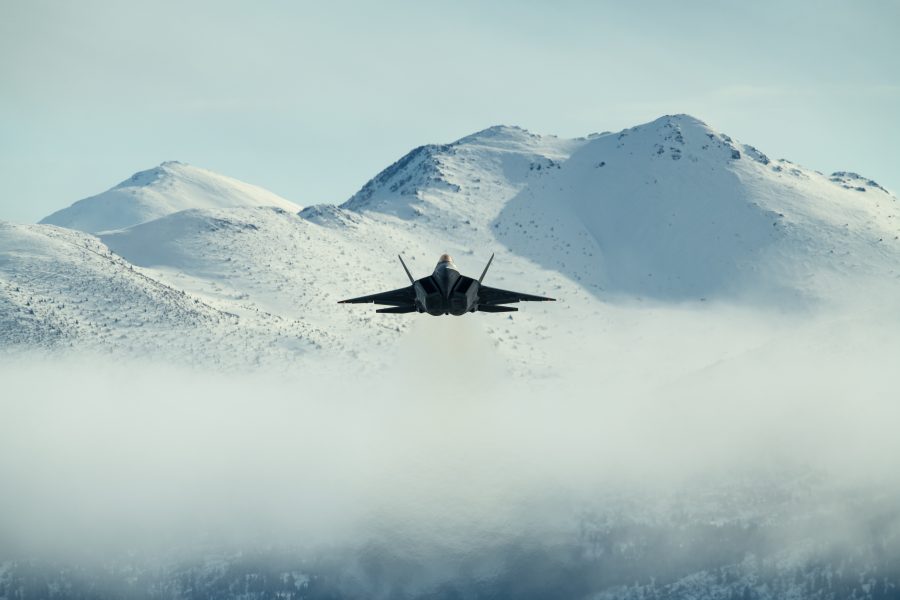A recent seven-day exercise sent Air Force F-22s—along with other USAF aircraft—to austere, challenging environments across Guam and the Northern Mariana Islands.
Agile Reaper, taking place for the second time after its inaugural edition last year, featured 800 Airmen and 29 aircraft across five different locations from April 10-16, training on the Agile Combat Employment concept that leaders say will define the service in the years to come.
The 3rd Air Expeditionary Wing from Joint Base Elmendorf-Richardson, Alaska, conducted simulated combat situations and tested agility in deploying combat air power across the expansive Indo-Pacific region.
“The goal is to develop resilient warfighters who are confident in their ability to execute using mission-type orders, generate airlift sorties in a contested environment with limited resources and grow together as a diverse team while gaining familiarity with other career fields,” Lt. Col. Logan Sutton, 535th Airlift Squadron commander, said in a release.
The exercise used a hub-and-spoke model: Andersen Air Force Base, Guam, served as the central hub, while Saipan and Tinian of the Northern Mariana Islands, the Japanese island of Iwo To, and Andersen’s Northwest Field served as the spokes for the exercise.
Many of the spokes have limited resources and bare-bones facilities. While the Northwest Field is on Guam, it is separated from the rest of the base.
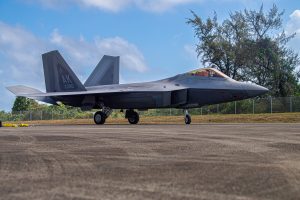
An F-22 Raptor assigned to the 90th Expeditionary Fighter Squadron out of Joint Base Elmendorf-Richardson, Alaska, arrives at Tinian International Airport during Exercise Agile Reaper 24-1 at Tinian Forward Operating Site, Northern Mariana Islands, April 10, 2024. AR 24-1 is a 3rd Wing-sponsored Exercise that focuses on Agile Combat Employment and employs a hub-and-spoke concept of operations with Tinian FOS serving as one of the five disaggregated spokes and a hub situated at Andersen Air Force Base, Guam. The exercise employs combat-representative roles and processes to deliberately target all participants as a training audience and stress the force’s capability to generate combat air power in an expeditious manner across the Indo-Pacific Region. (U.S. Air Force photo by Tech. Sgt. Curt Beach)
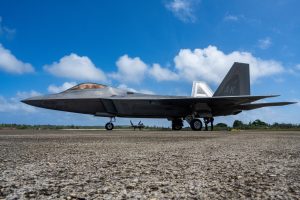
An F-22 Raptor assigned to the 90th Expeditionary Fighter Squadron out of Joint Base Elmendorf-Richardson, Alaska, arrives at Tinian International Airport during Exercise Agile Reaper 24-1 at Tinian Forward Operating Site, Northern Mariana Islands, April 10, 2024. AR 24-1 is a 3rd Wing-sponsored Exercise that focuses on Agile Combat Employment and employs a hub-and-spoke concept of operations with Tinian FOS serving as one of the five disaggregated spokes and a hub situated at Andersen Air Force Base, Guam. The exercise employs combat-representative roles and processes to deliberately target all participants as a training audience and stress the force’s capability to generate combat air power in an expeditious manner across the Indo-Pacific Region. (U.S. Air Force photo by Tech. Sgt. Curt Beach)
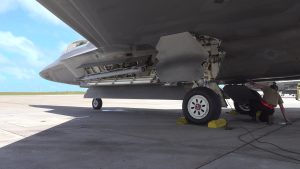
U.S. Air Force Senior Airman Ricardo Chavez, F-22 crew chief, 90th Fighter Generation Squadron, 3rd Air Expeditionary Wing, conducts an inspection for an F-22 Raptor, April 9, 2024, Anderson Air Force Base, Guam. The 90th Fighter Generation Squadron is part of the 3rd Air Expeditionary Wing, a force package made of personnel in the 3rd Wing, 673rd Air Base Wing, 176th Wing, 477th Fighter Group, all from Joint Base Elmendorf-Richardson, Alaska, as well as units from the 15th Wing, Joint Base Pearl Harbor-Hickam, Hawaii; and the 168th Wing, Eielson AFB, Alaska. (Alaska Air National Guard photo by Staff Sgt. Kelly Willett)
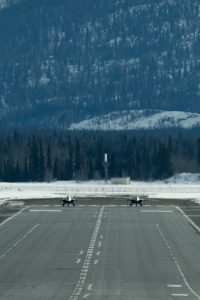
U.S. Air Force F-22 Raptors assigned to the 90th Fighter Squadron take off from Joint Base Elmendorf-Richardson, Alaska, April 7, 2024, for Agile Reaper 24-1. AR 24-1 is an effort from JBER’s 3rd Air Expeditionary Wing to exercise Agile Combat Employment. The exercise will use combat-representative roles and processes to deliberately target all participants as a training audience and stress the force’s capability to generate combat air power across the Indo-Pacific region. (U.S. Air Force photo by Senior Airman Patrick Sullivan)
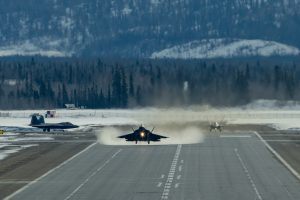
U.S. Air Force F-22 Raptors assigned to the 90th Fighter Squadron take off from Joint Base Elmendorf-Richardson, Alaska, April 7, 2024, for Agile Reaper 24-1. AR 24-1 is an effort from JBER’s 3rd Air Expeditionary Wing to exercise Agile Combat Employment. The exercise will use combat-representative roles and processes to deliberately target all participants as a training audience and stress the force’s capability to generate combat air power across the Indo-Pacific region. (U.S. Air Force photo by Senior Airman Patrick Sullivan)
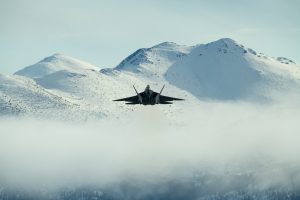
A U.S. Air Force F-22 Raptor assigned to the 90th Fighter Squadron takes off from Joint Base Elmendorf-Richardson, Alaska, April 7, 2024, for Agile Reaper 24-1. AR 24-1 is an effort from JBER’s 3rd Air Expeditionary Wing to exercise Agile Combat Employment. The exercise will use combat-representative roles and processes to deliberately target all participants as a training audience and stress the force’s capability to generate combat air power across the Indo-Pacific region. (U.S. Air Force photo by Senior Airman Patrick Sullivan)
F-22s from Elmendorf-Richardson and Joint Base Pearl Harbor-Hickam, Hawaii, flew across the Pacific for the exercise. Elmendorf-Richardson also sent an HC-130 Combat King II for air refueling and a C-12 Huron for transport, a base spokesperson to Air & Space Forces Magazine. KC-46 and KC-135 tankers came from McConnell Air Force Base, Kan., and Eielson Air Force Base, Alaska, respectively.
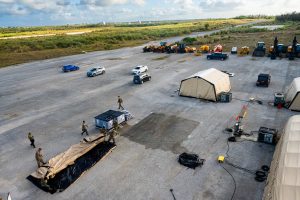
U.S. Air Force Airmen assigned to the 3rd Air Expeditionary Wing out of Joint Base Elmendorf-Richardson, Alaska, break down an expeditionary tent during the reaggregation phase of Exercise Agile Reaper 24-1 at Northwest Field spoke, Andersen Air Force Base, Guam, April 15, 2024. AR 24-1 serves as an Air Force Force Generation (AFFORGEN) certifying training event for the 3rd AEW, a requirement for the deployment of forces. AFFORGEN is an evolving concept that allows the Department of the Air Force to ensure force presentation and force generation models are aligned to the way the service intends to operate in the future high-end fight. (U.S. Air Force photo by Tech. Sgt. Curt Beach)
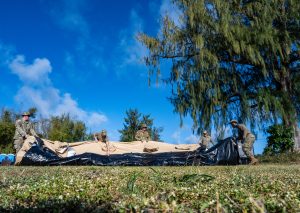
U.S. Air Force Airmen from the 3rd Air Expeditionary Wing out of Joint Base Elmendorf-Richardson, Alaska, set up an expeditionary tent during Exercise Agile Reaper 24-1 at Tinian Forward Operating Site, Northern Mariana Islands, April 8, 2024. The expeditious build-up of the Tinian FOS was made possible through the employment of the Air Force concept of Mission-Ready Airmen. MRA optimizes wartime operational mission generation through Airmen working side-by-side with Airmen outside their Air Force Specialty Code and applying those core skills when needed, in order to make the mission happen. In a wartime environment, ensuring redundancies with Airmen understanding and being able to act outside their core specialty will increase the survivability and effectiveness of forces in the Pacific. (U.S. Air Force photo by Tech. Sgt. Curt Beach)
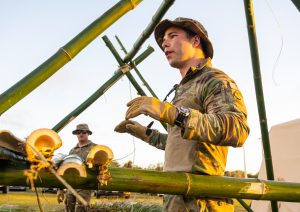
U.S. Air Force Staff Sgt. Cole Durand, a 3rd Expeditionary Operations Support Squadron Survival, Evasion, Resistance and Escape specialist out of Joint Base Elmendorf-Richardson, Alaska, gives direction to Airmen from the 3rd Air Expeditionary Wing on using bamboo to build a shelter during Exercise Agile Reaper 24-1 at Tinian Forward Operating Site, Northern Mariana Islands, April 9, 2024. The expeditious build-up of the Tinian FOS was made possible through the employment of the Air Force concept of Mission-Ready Airmen. MRA optimizes wartime operational mission generation through Airmen working side-by-side with Airmen outside their Air Force Specialty Code and applying those core skills when needed, in order to make the mission happen. In a wartime environment, ensuring redundancies with Airmen understanding and being able to act outside their core specialty will increase the survivability and effectiveness of forces in the Pacific. (U.S. Air Force photo by Tech. Sgt. Curt Beach)
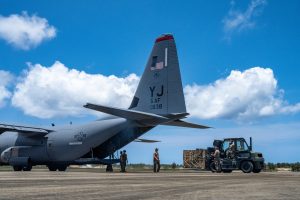
U.S. Air Force aerial porters from the 176th Logistics Readiness Squadron out of Joint Base Elmendorf-Richardson, Alaska, and the 734th Air Mobility Squadron out of Andersen Air Force Base, Guam, prepare cargo for airlift during the reaggregation phase of Exercise Agile Reaper 24-1 at Tinian spoke, Northern Mariana Islands, April 17, 2024. AR 24-1 is a 3rd Wing-led exercise that focuses on Agile Combat Employment and a hub-and-spoke concept of operations with an operations center, or hub, located at Andersen Air Force Base, Guam, and four disaggregated locations serving as spokes. The exercise employs combat-representative roles and processes to deliberately target all participants as a training audience and stress the force’s capability to generate combat air power in an expeditious manner across the Indo-Pacific Region. (U.S. Air Force photo by Tech. Sgt. Curt Beach)
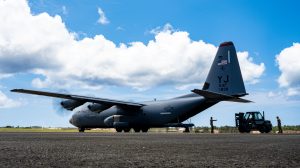
A U.S. Air Force C-130 Hercules out of Yokota Air Base, Japan, prepares for takeoff to transport service members and cargo back to Andersen Air Force Base, Guam, during the reaggregation phase of Exercise Agile Reaper 24-1 at Tinian spoke, Northern Mariana Islands, April 17, 2024. AR 24-1 is an effort from the 3rd Air Expeditionary Wing, composed of several units from JBER; Eielson Air Force Base, Alaska; Yokota AB; and Joint Base Pearl Harbor-Hickam, Hawaii, coming together as the 3rd AEW to exercise Agile Combat Employment, rehearse capabilities in an operationally relevant environment and to provide air dominance, global mobility and command and control with a hub-and-spoke system of operations based out of Andersen AFB. The 3rd AEW Airmen are training as Mission-Ready Airmen (MRA), focusing on a mix of skills needed to optimize wartime operational mission generation. (U.S. Air Force photo by Tech. Sgt. Curt Beach)
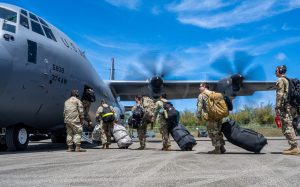
U.S. Air Force Airmen assigned to the 3rd Air Expeditionary Squadron out of Joint Base Elmendorf-Richardson, Alaska, board a C-130 Hercules out of Yokota Air Base, Japan, during the reaggregation phase of Exercise Agile Reaper 24-1 at Tinian spoke, Northern Mariana Islands, April 17, 2024. Approximately 800 U.S. Air Force Airmen flew, maintained and supported 29 aircraft operating at five disaggregated locations during AR 24-1. The exercise employed combat-representative roles and processes to deliberately target all participants as a training audience and stress the force’s capability to generate combat air power in an expeditious manner across the Indo-Pacific Region. (U.S. Air Force photo by Tech. Sgt. Curt Beach)
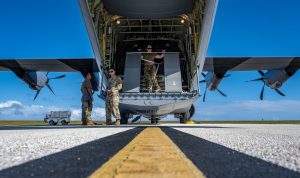
U.S. Air Force Airmen assigned to the 36th Airlift Squadron out of Yokota Air Base, Japan, prepare a C-130J Hercules for takeoff to Tinian spoke during Exercise Agile Reaper 24-1 at Andersen Air Force Base, Guam, April 8, 2024. AR 24-1 is an effort from the 3rd Air Expeditionary Wing, composed of several units from Joint Base Elmendorf-Richardson, Alaska; Eielson Air Force Base, Alaska; Yokota Air Base, Japan; and Joint Base Pearl Harbor-Hickam, Hawaii, coming together as the 3rd AEW to exercise Agile Combat Employment, rehearse capabilities in an operationally relevant environment and to provide air dominance, global mobility and command and control with a hub-and-spoke system of operations based out of Andersen AFB. The 3rd AEW Airmen are training as Mission-Ready Airmen (MRA), focusing on a mix of skills needed to optimize wartime operational mission generation. (U.S. Air Force photo by Tech. Sgt. Curt Beach)
Travis Air Force Base, Calif., dispatched its C-5 Galaxy, and Yokota Air Base, Japan, contributed a C-130 Hercules to transport service members and cargo back and forth between Guam.
“The Airmen landed in Saipan with limited resources and quickly worked to secure food, water, shelter and operational necessities,” Sutton said. “These competencies have been exercised routinely in specialized military units. However, doing so at scale with Mission Ready Airmen increases the flexibility and effectiveness of joint maneuver forces throughout the theater.”
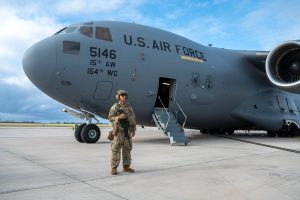
Airman 1st Class Freddy Reynaga, Security Response Team, 647th Security Forces Squadron stands guard outside a C-17 Globemaster III during Exercise Agile Reaper 24-1 in Saipan, North Mariana Islands, 6 April 2024. Approximately 250 personnel from three locations traveled to participate in training within an environment where they can operate at the level of stress that will increase responsiveness to natural disasters and other challenges to better support the Pacific. (Photo by U.S. Air Force Technical Sgt. Tarelle Walker)
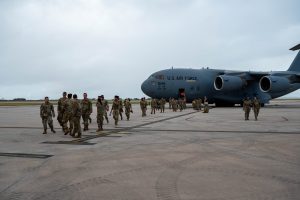
New arrivals deplane from a C-17 Globemaster III during Exercise Agile Reaper 24-1 in Saipan, North Mariana Islands, 6 April, 2024). Approximately 250 personnel from three locations traveled to participate in training within an environment where they can operate at the level of stress that will increase responsiveness to natural disasters and other challenges to better support the Pacific. (Photo by U.S. Air Force Technical Sgt. Tarelle Walker)
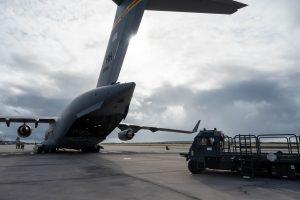
The Air Transportation team from the 647th Logistics Readiness Squadron, prepare to unload cargo from a C-17 Globemaster III during Exercise Agile Reaper 24-1 in Saipan, North Mariana Islands, 6 April, 2024. Approximately 250 personnel from three locations traveled to participate in training within an environment where they can operate at the level of stress that will increase responsiveness to natural disasters and other challenges to better support the Pacific. (Photo by U.S. Air Force Technical Sgt. Tarelle Walker)
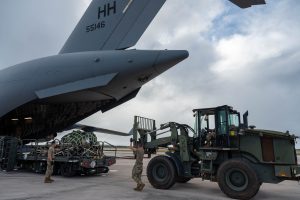
The Air Transportation team with the 647th Logistics Readiness Squadron, operates a Forklift to unload cargo from the back of a C-17 Globemaster III during Exercise Agile Reaper 24-1, 6 April, 2024. Approximately 250 personnel from three locations traveled to participate in training within an environment where they can operate at the level of stress that will increase responsiveness to natural disasters and other challenges to better support the Pacific. (Photo by U.S. Air Force Technical Sgt. Tarelle Walker)
Col. Kevin Jamieson, 3rd Wing and 3rd Air Expeditionary Wing commander of the Elmendorf-Richardson said this year’s training was to test “the limits of what a cohesive 3rd AEW is capable of in a combat-representative environment” based on the experience on Guam and Tinian last year. The training also served as the Air Force Force Generation (AFFORGEN) certification for the wing, a requirement for the service’s deploying forces.
Significant support operations were provided from Pearl Harbor-Hickam and Elmendorf-Richardson. While the main exercise concluded earlier this month, the rest of the forces continued to provide support until April 29, the spokesperson added.
